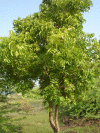Valorizing the 'Irulas' traditional knowledge of medicinal plants in the Kodiakkarai Reserve Forest, India
- PMID: 19366462
- PMCID: PMC2681454
- DOI: 10.1186/1746-4269-5-10
Valorizing the 'Irulas' traditional knowledge of medicinal plants in the Kodiakkarai Reserve Forest, India
Abstract
A mounting body of critical research is raising the credibility of Traditional Knowledge (TK) in scientific studies. These studies have gained credibility because their claims are supported by methods that are repeatable and provide data for quantitative analyses that can be used to assess confidence in the results. The theoretical importance of our study is to test consensus (reliability/replicable) of TK within one ancient culture; the Irulas of the Kodiakkarai Reserve Forest (KRF), India. We calculated relative frequency (RF) and consensus factor (Fic) of TK from 120 Irulas informants knowledgeable of medicinal plants. Our research indicates a high consensus of the Irulas TK concerning medicinal plants. The Irulas revealed a diversity of plants that have medicinal and nutritional utility in their culture and specific ethnotaxa used to treat a variety of illnesses and promote general good health in their communities. Throughout history aboriginal people have been the custodians of bio-diversity and have sustained healthy life-styles in an environmentally sustainable manner. However this knowledge has not been transferred to modern society. We suggest this may be due to the asymmetry between scientific and TK, which demands a new approach that considers the assemblage of TK and scientific knowledge. A greater understanding of TK is beginning to emerge based on our research with both the Irulas and Malasars; they believe that a healthy lifestyle is founded on a healthy environment. These aboriginal groups chose to share this knowledge with society-at-large in order to promote a global lifestyle of health and environmental sustainability.
Figures








Similar articles
-
Ethnobotany genomics - discovery and innovation in a new era of exploratory research.J Ethnobiol Ethnomed. 2010 Jan 26;6:2. doi: 10.1186/1746-4269-6-2. J Ethnobiol Ethnomed. 2010. PMID: 20102622 Free PMC article.
-
Consensus of the 'Malasars' traditional aboriginal knowledge of medicinal plants in the Velliangiri holy hills, India.J Ethnobiol Ethnomed. 2008 Mar 27;4:8. doi: 10.1186/1746-4269-4-8. J Ethnobiol Ethnomed. 2008. PMID: 18371206 Free PMC article.
-
Indigenous knowledge of medicinal plants used by the Reang tribe of Tripura state of India.J Ethnopharmacol. 2014 Feb 27;152(1):135-41. doi: 10.1016/j.jep.2013.12.037. Epub 2014 Jan 7. J Ethnopharmacol. 2014. PMID: 24412549
-
Traditional use of medicinal plants in the boreal forest of Canada: review and perspectives.J Ethnobiol Ethnomed. 2012 Jan 30;8:7. doi: 10.1186/1746-4269-8-7. J Ethnobiol Ethnomed. 2012. PMID: 22289509 Free PMC article. Review.
-
Aboriginal medicinal plants of Queensland: ethnopharmacological uses, species diversity, and biodiscovery pathways.J Ethnobiol Ethnomed. 2022 Aug 10;18(1):54. doi: 10.1186/s13002-022-00552-6. J Ethnobiol Ethnomed. 2022. PMID: 35948982 Free PMC article. Review.
Cited by
-
Callus mediated shoot organogenesis and regeneration of cytologically stable plants of Ledebouria revoluta: An ethnomedicinal plant with promising antimicrobial potency.J Genet Eng Biotechnol. 2018 Dec;16(2):645-651. doi: 10.1016/j.jgeb.2018.05.002. Epub 2018 Nov 12. J Genet Eng Biotechnol. 2018. PMID: 30733784 Free PMC article.
-
Evaluation of Phytochemicals and Bioactive Properties in Mangrove Associate Suaeda monoica Forssk. ex J.F.Gmel. of Indian Sundarbans.Front Pharmacol. 2021 Mar 10;12:584019. doi: 10.3389/fphar.2021.584019. eCollection 2021. Front Pharmacol. 2021. PMID: 33790782 Free PMC article.
-
Assessment of Achyranthes aspera induced toxicity and molecular analysis of RAPD-PCR profiles of larval genomic DNA of Aedes aegypti L. (Diptera: Culicidae).J Parasit Dis. 2017 Dec;41(4):1066-1073. doi: 10.1007/s12639-017-0935-1. Epub 2017 Jun 24. J Parasit Dis. 2017. PMID: 29114143 Free PMC article.
-
An ethnobotanical survey of medicinal plants used in Terai forest of western Nepal.J Ethnobiol Ethnomed. 2012 May 16;8:19. doi: 10.1186/1746-4269-8-19. J Ethnobiol Ethnomed. 2012. PMID: 22591592 Free PMC article.
-
Ethnobotany genomics - discovery and innovation in a new era of exploratory research.J Ethnobiol Ethnomed. 2010 Jan 26;6:2. doi: 10.1186/1746-4269-6-2. J Ethnobiol Ethnomed. 2010. PMID: 20102622 Free PMC article.
References
-
- Usher PJ. Traditional ecological knowledge in environmental assessment and management. Arctic. 2000;53:183–93.
-
- Cooke B, Kothari U. Participation: the New Tyranny? London, Zed Books; 2001. The case for participation as tyranny; pp. 1–15.
-
- Trotter R, Logan M. Informant consensus: a new approach for identifying potentially effective medicinal plants. In: Etkin NL, editor. Plants in indigenous medicine and diet: biobehavioural approaches. New York, Redgrave Publishers; 1986. pp. 91–112.
-
- Phillips O, Gentry AH. The useful plants of Tambopata, Peru: I. Statistical hypotheses tests with a new quantitative technique. Econ Bot. 1993;47:15–32.
MeSH terms
LinkOut - more resources
Full Text Sources
Other Literature Sources
Medical

